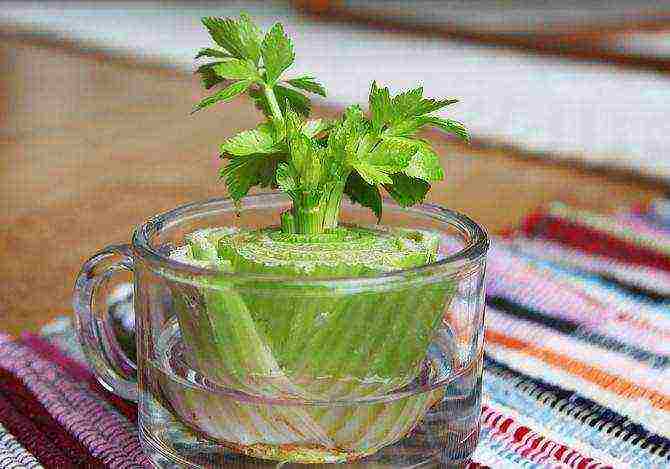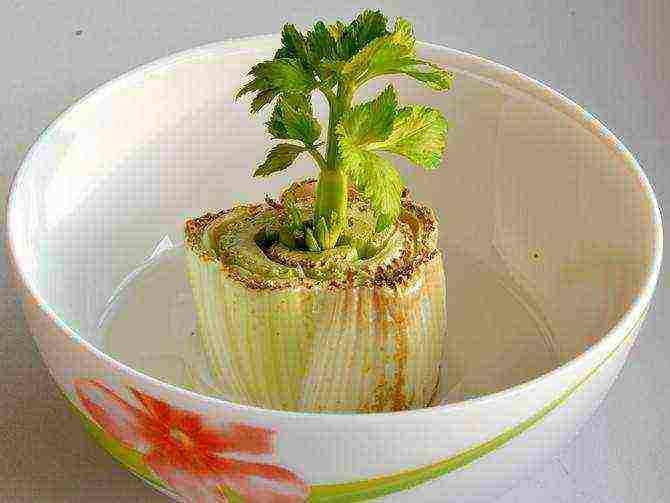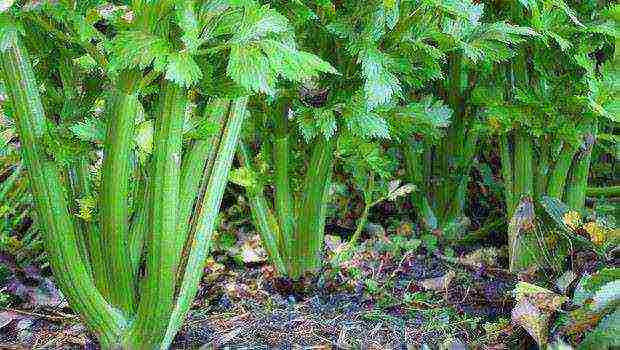Content
EFFECTIVE CULTIVATION IN HOME CONDITIONS FROM ROOTS TO GREENS
 Greetings, dear friends!
Greetings, dear friends!
Celery is the tone of the body, beauty and strength. Regular inclusion of leafy greens in the diet, including celery, helps to replenish the lack of vitamins and various nutrients (mineral salts, dietary fiber, chlorophyll, trace elements), which is especially important in the cold season.
Plus, celery is an excellent seasoning that can add exquisite notes to almost any hot dish, be it borsch, pickle or stew. To constantly have this wonderful greenery at hand, it is enough to plant it in your home mini-garden (on the windowsill).
How to grow celery at home
Preparing the soil
The soil should be sufficiently loose, for example, turf with the addition of peat or humus. You can buy a ready-made soil-soil mixture (a universal one is suitable), or better - prepare it yourself. To do this, mix 2 parts of garden soil with one part of humus (peat is possible), add a large spoonful of wood ash for each kilogram of earth and heat the resulting mixture in the oven for an hour (this is necessary in order to get rid of the pathogens present).
Planting material
You can buy root vegetables in a regular store or bring them from a summer cottage (See the article "Growing root celery") They should be more than 5 cm in diameter. Pay special attention to the petioles - they should not be damaged and cut off by more than 3 cm, which gives a guarantee of the safety of the apical buds, which are the basis of future greenery.
Landing
We fill the container intended for the plant (pot, wooden or plastic box) with soil. It is imperative to make a drainage layer of expanded clay, small pebbles or finely broken bricks (about 2 cm). If the planting box is not deep enough for the selected root crops, then their lower part should be carefully trimmed.
We plant root crops in abundantly moistened soil with a step of 6-7 cm so that all plants have the opportunity to develop normally. We place the roots in the ground at a slight angle. Fill the soil mixture in layers. The apical buds remain open.
Containers with planted roots should be placed for 10 days in a room with a temperature of + 5 ° C to + 12 ° C, for example, on the balcony or near it. Watering during this period should be moderate, every 2-3 days. In the future, when the apical kidney hatches, the box can be placed in a permanent place - on the windowsill. Celery loves an abundance of light, so choose windows facing south, southeast, and southwest to create a green bed.
Watering and feeding
To prevent the root crop from rotting, the celery should be watered with heated, settled water. It is recommended to feed the plant 2 weeks after planting. To do this, we use liquid ready-made fertilizers (extracts from organic matter), which are diluted with water according to the instructions. In the future, feeding is advised to be carried out after each harvest.
Watering is desirable in the center of each root crop. This gives a good impetus for growth, nutrition and development of the root system, and then strong and lush young shoots will appear there. Watering should not be too abundant.
Features of growing celery at home
When growing celery at home, it is recommended to cut the yellowed lower leaves that have not adapted to room conditions (to the end, so that there are no cuttings left).
To prevent root rotting, regularly loosen the soil with a regular fork. You can also dust the topsoil with wood ash once a month.
The air temperature at the place where the celery grows should not exceed 18 ° C. In winter, the plant must be supplemented, since any leafy greens are photophilous. To do this, use lamps (ordinary daylight or special phytolamps), installing them at a distance of 60-65 cm above the shoots.
3-4 weeks after planting celery, you can harvest your first flavorful crop by adding healthy green leaves to the table. When the root system of plants is depleted, then it will be possible to replace them with a new batch.
In order to create a green vegetable garden on the windowsill, it is not at all necessary to have special agrotechnical knowledge. Your desire and following the simplest recommendations of experienced gardeners are quite enough. See you, friends!
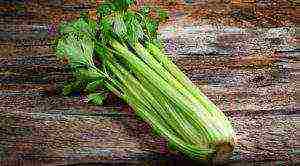
Celery - one of the faithful companions of mankind since antiquity. In ancient Greece, this plant was highly valued not only as a vegetable, but also as an amulet that brings happiness. It was woven into the wreaths of the victors, and the tombs were decorated with it to ward off death from other family members.
…
Celery grows on every continent except Antarctica and is found in the wild. Cultivated celery can be root, stalked and deciduous, the cultivation technique and method of use depend on it.
Planting celery
Root celery has a long growing season (170-180 days) and is therefore grown in seedlings. The seeds must certainly be fresh, already in the second year of storage, the germination rate drops sharply.
In early to mid-February, the seeds are soaked for three days in snow water, changing it three times a day. A mixture of sand and humus is poured into boxes or cups in equal proportions, seeds are sown and sprinkled with a layer of substrate no more than 0.2-0.5 cm.
Frequent shoots must be thinned out and the seedlings should be kept in the brightest possible place, otherwise it will stretch out.
Watering is sufficient, but moderate. The temperature must be maintained within 15-180 C. When a pair of real leaves appear, the seedlings need to be cut into pots or paper cups, deepening part of the stem into the ground and pinching the root, and after 15 days, feed them with nitrophos (1 tsp for 3 liters of water, two tablespoons of solution per plant when watering) ... Before planting in the ground, the plants are hardened for several days in a cool place.
When a pair of real leaves appear, the seedlings need to be cut into pots or paper cups, deepening part of the stem into the ground and pinching the root, and after 15 days, feed them with nitrophos (1 tsp for 3 liters of water, two tablespoons of solution per plant when watering) ... Before planting in the ground, the plants are hardened for several days in a cool place.
In mid or late May, when the threat of frost has passed, celery is planted in open ground. If the soil is clay or peaty, a bucket of humus, a couple of tablespoons of nitrophoska, a couple of glasses of wood ash or chalk, 2-3 cans of sand should be added to a standard bed.
Having mixed well and loosening the soil to a depth of 30-40 cm, celery is planted in the afternoon at a distance of 30-35 cm between rows and 15-20 cm between plants. In no case should the plants be buried when planting, but they should be watered better.
Secrets of growing asparagus beans on our website.
Read here all about planting beans.
The answer to the question "How to grow peas?" ...
Growing celery
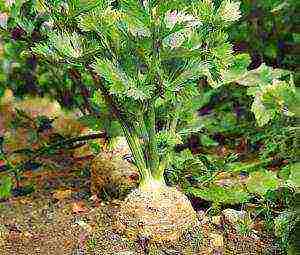 After rooting, new leaves appear on the plants. This means that it is time to take care of the shape of the future root crop. The soil is carefully raked from the plant and the lateral horizontal roots are removed. If this is not done, the root can grow branched and tough. It is contraindicated to huddle plants, even when loosening it, you need to make sure that the stem does not have excess soil, and by the end of the growing season and gaining mass, you should carefully rake off the soil from the base of the stem.
After rooting, new leaves appear on the plants. This means that it is time to take care of the shape of the future root crop. The soil is carefully raked from the plant and the lateral horizontal roots are removed. If this is not done, the root can grow branched and tough. It is contraindicated to huddle plants, even when loosening it, you need to make sure that the stem does not have excess soil, and by the end of the growing season and gaining mass, you should carefully rake off the soil from the base of the stem.
Caring for celery during the growth process consists of watering, weeding, loosening and feeding.During the summer, until about mid-August, leaves should not be plucked from the plant, celery uses them to accumulate root mass, but by the end of the growing season, it is better to cut off the lower branches.
During growth, celery needs good watering, but does not like waterlogging, and sour soil can spoil the marketable and taste qualities of the root.
Top dressing is best done during watering: one tbsp. We take a spoonful of superphosphate, urea and potassium per 10 liters of water and use it per 2 m2 of soil. Top dressing should be carried out 2-3 times during the summer, but no later than a month before harvesting.
Celery harvest begins around mid-October. Frosts of 1-3 degrees are not terrible for him. Root crops are carefully removed from the soil, cleaned of soil and tops, and stored in the basement. You can sprinkle the celery with sand, store it at a temperature of 1-20.
The benefits of celery
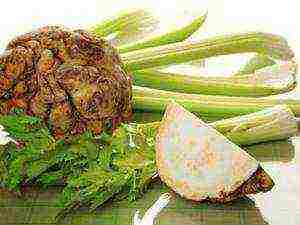 Celery - an excellent spicy-aromatic plant that is used not only for food, but also as a means of traditional medicine. Celery root vegetables are used in salads, vegetable stews, meat and fish dishes. Its use is very useful in getting rid of excess weight, in the treatment of atherosclerosis, disorders of nervous and cardiac activity.
Celery - an excellent spicy-aromatic plant that is used not only for food, but also as a means of traditional medicine. Celery root vegetables are used in salads, vegetable stews, meat and fish dishes. Its use is very useful in getting rid of excess weight, in the treatment of atherosclerosis, disorders of nervous and cardiac activity.
Celery juice restores the correct metabolism, gently heals the entire body. It has been proven to have a healing effect on prostatitis for the treatment and improvement of potency. A large amount of fiber in celery has a beneficial effect on the intestines, and vitamins and biologically active substances support the body's tone.
We recommend that you find out the beneficial properties of dill.
Read when to sow cabbage for seedlings here
So, celery is not just a tasty and fragrant vegetable that everyone can grow with their own hands, applying our advice, but a real storehouse of healing substances that can heal, help with diseases and restore a great mood and well-being. Therefore, celery should be on the table of every person, regardless of age, profession and place of residence. It was not for nothing that the wise ancient Greeks called it “the grass of happiness”.
In winter, especially when it is frosty and very cold outside, it will be nice to see fresh herbs on the table. She will not only decorate the dishes and diversify the menu, but also present a large amount of vitamins. Therefore, you need to use every opportunity and available conditions to grow greens yourself.
Celery, when purchased in a store, is not completely consumed in food. The inedible part of it remains, which is most often thrown away. But it turns out that from this inedible part, you can grow celery again, at home.
Forcing celery greens at home
In order to start growing celery greens, you need to prepare a half-liter jar or a small cup, plain water, a knife and a bunch of store-bought stalked celery.
In a bunch of celery there is the lowest part (at the very root), which is not suitable for food. Cut off this part and lower it into a container with water. The water should only cover half of this base cut from the bundle. The container with the plant must be placed in a well-lit place. Choose a windowsill on the sunny side. Celery is a heat-loving and light-loving plant.
All that will need to be done in the future is to add water on time to the initial rate. Only a few days will pass, and the first shoots of greenery will appear. And after about a week, not only young green twigs will noticeably grow up, but also a root system will begin to form. In this form, celery can continue to grow in water conditions, or you can already transplant it into a flower pot. It will feel equally good in a container with water and in soil. Its growing location will not in any way affect the future greenery harvest.
This is how, without much hassle, you can turn plant waste into wholesome and nutritious food.
Celery
Published by 13.01.2015 |
Celery is not only an excellent seasoning for hot dishes, but also strength, beauty, body tone.
Characteristics and properties
The peculiarity of celery is that the whole plant (foliage, stalks, roots) can be used in cooking.
In this regard, there are three types of celery.
Leafy celery - with a growing season of 80 - 90 days. This variety of celery is distinguished by its small stalk, thin root and abundant greenery during the growing season.
Petiole celery - with a growing season of 110 - 180 days. This subspecies has a powerful long (up to 50 cm) petiole, for the sake of which it is grown.
Root - its growing season is 140-200 days. Roots can weigh up to 500 grams.Varieties
For cultivation on personal plots, you can recommend the time-tested varieties of celery: "Apple", "Delicacy", "Gribovsky", "Snowball".
Site organization and soil preparation
Celery is whimsical to the soil of the site. You should select a fertile, fairly light soil with a good introduction of organic matter, except for fresh manure. Neutral sandy loam fertilized with peat, humus or rotted oyster mushrooms are ideal. The introduction of this type of fertilizer is carried out in the fall with digging up the soil to a depth of 30 cm.
Of the mineral fertilizers, the most suitable will be superphosphate or complex fertilizers of a wide spectrum of action.
Predecessors
Growing celery in areas where dill, carrots or parsley were predecessors is unacceptable.
Sowing time
Sowing celery for seedlings at home should be done as early as possible. For early leafy greens, seeds can be sown from late February. Varieties of petiole and root celery are sown from March to April in such a way that by the time of planting the sprouts have formed 5 - 6 true leaves.
Sowing preparation
Presowing treatment of celery seeds consists in washing them with a weak solution of potassium permanganate, followed by soaking in water for up to 24 hours. After that, the seeds are left warm and in a damp cloth until the sprouts hatch. Next, the seeds are carefully laid out in narrow, shallow grooves with a row spacing of 3 cm and lightly sprinkled with soil.
Sowing and caring for seedlings
Seeds for planting are taken per square meter up to 2 grams. Sow them, trying to adhere to a distance of 5-6 cm. The desired germination temperature is about 20 degrees. The germination process itself can take up to 20 days. Crop care consists in loosening row spacings and thinning crops. After the emergence of the second true leaf on the seedlings, the sprouts should be picked.
Landing in the ground
Leafy celery can be planted directly in the ground from late April to early May. The sowing rows are arranged with a row spacing of 30 cm. The seed is very small, so it can be simply laid out on the soil surface, moistened with a sprayer and covered with a foil with gaps for air circulation until sprouts form. Alternatively, the decomposed and moistened seeds are sprinkled with a thin layer of moistened sand.Planting of seedlings of leaf celery in the ground is carried out when five true leaves are formed on the sprouts.
Petiolate celery for seedlings is sown from mid-March so that 50-day-old seedlings can be planted in the ground in early May. The last week, the seedlings are hardened in the open air with a gradual increase in the duration of the procedure.
Planting stalked celery in the ground is carried out in rows with a row spacing of 40 cm and a distance between bushes of 30 cm. Before planting, the roots of the seedlings are shortened by a third, and the cut itself is sprinkled with charcoal ash.
For root celery, seedlings are grown for at least two months and planted according to the scheme for stalked celery.
Care
For celery, good illumination with moderate watering, as well as loosening row spacings and controlling weeds, is of great importance. During active growth, fertilizing with urea at the rate of 10 g per bucket of water will not interfere.
Pests
Celery is not very susceptible to pests, however, during the period of distillation of seedlings, the greens can be spoiled by the carrot leaf.
Harvesting
As the leaves mature and regrow, the greens of the leaf celery are cut throughout the growing season. The stalked celery is harvested in early October and the roots are dug out during the preparation of the garden for wintering.
Any part of celery can be used as food. If by chance a root is planted instead of a variety of leaf celery, there is no point in replanting such a site again. There will be a little less greenery from such celery, but for the winter you can prepare an additional crop of fragrant and nutritious roots.
